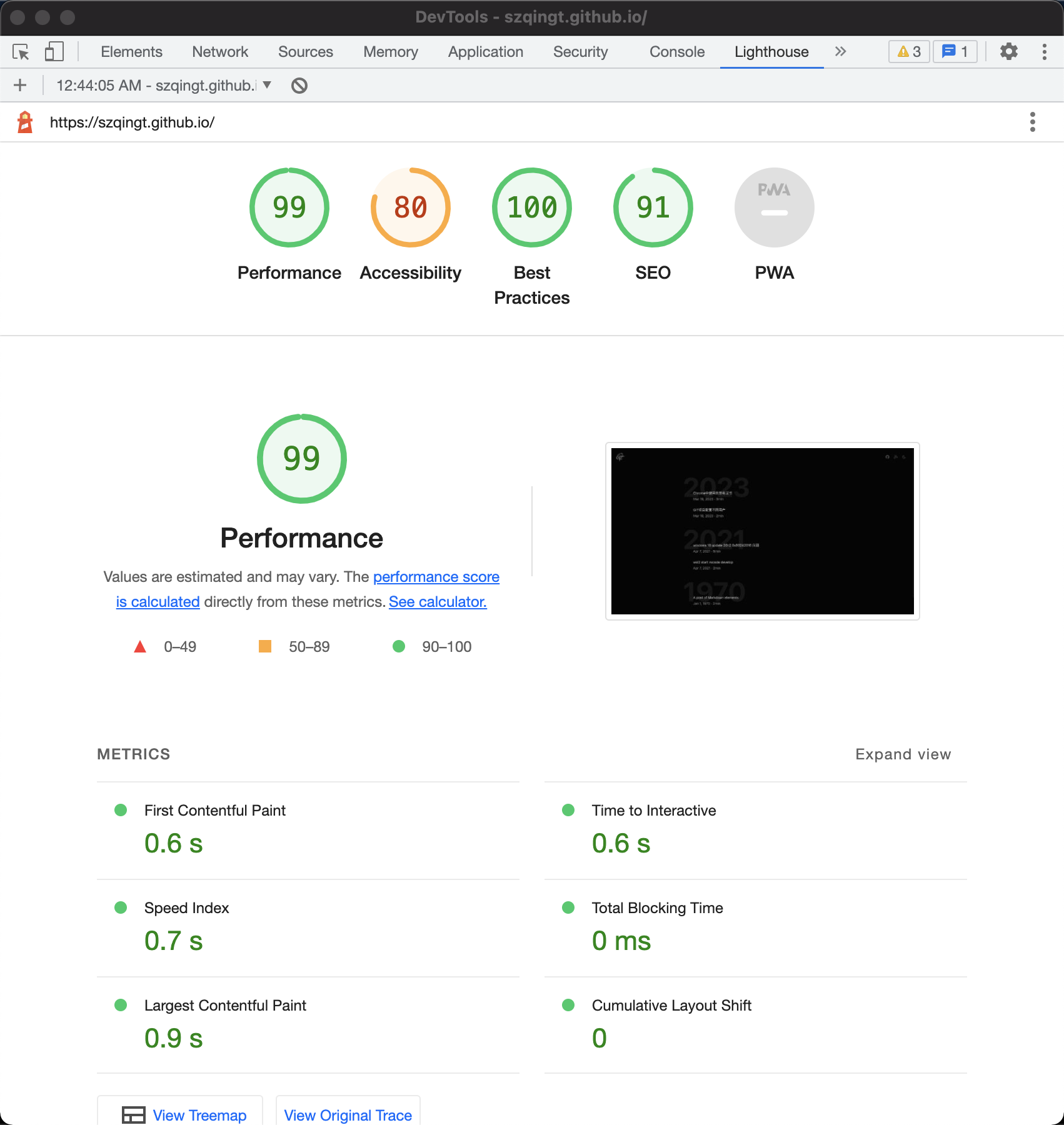什么是Astro
根据官网描述,Astro是集多功能于一体的 Web 框架,用于构建快速、以内容为中心的网站。可以看出Astro是一个Web框架,和Nuxt、Next.js类似的Web框架,为啥有了目前这么流行的框架存在Astro还能得到这么大的关注?
为什么要为Astro
如他文档说的目前的框架大都主要为了构建应用而设计,对内容站没有更多的优化。什么是内容站,以展示为主没有很重复杂的交互逻辑的Web程序比如文档网站、博客、出版网站等等。为啥Astro突然很火了,初次看感觉这不和Next.js、Nuxt.js不是差不多吗,为啥它出圈了?我将它理解为拼多多之于淘宝、京东,拼多多在细分的下沉做的市场更好。同样Astro在内容站的这个场景,提供了比其他框架更好的体验!那它到底好在哪儿?
- 学习成本不高。
.astro的语法和jsx比较类似 - 灵活性高。除了它自己的
.astro的方式,可以选择其他任何框架开发比如Vue、React都可以 - 提供内容站的良好支持。比如自带的
.md、.mdx解析,内容模版等等
群岛(Islands)架构
“群岛架构”由 Etsy 前端架构工程师 Katie Sylor-Miller提出,并由 Preact 的作者 Jason Miller 在这篇文章进行了扩展。
目前SSR、SSG这类应用,都是服务端直接给出 HTML 浏览器先进行渲染,然后加载 js 脚本完成事件绑定初始化数据,也就是经常听到的 hydration 的这个过程。当这个过程完成后页面才是一个完整可使用的页面。但是这个方案随着应用变大这个 hydration 的过程就会慢慢长导致可交互的事件也变长了!
群岛架构就是将页面进行拆分,拆分为静态内容、可交互岛屿两部分
 对于静态部分直接使用服务端返回的 HTML 就可以了,不用进行 hydration 这个过程,通过这种模式就可以实现局部的 hydration ,就能够减少 js 脚本的大小。
对于静态部分直接使用服务端返回的 HTML 就可以了,不用进行 hydration 这个过程,通过这种模式就可以实现局部的 hydration ,就能够减少 js 脚本的大小。
在Astro中默认组件是静态内容,对于需要交互的组件进行单独创建岛屿,这就是为啥它这么快的主要原因了。
使用Astro写Blog
搭建
前端起手式就是一个pnpm create astro@latest,安装后会提示你一些项目初始化、项目相关问题。这样一个Astro项目就创建好了。官方还提供了一个许多模板,我们可以直接选择一个 Blog 的模板,通过pnpm create astro@latest --template blog这种方式创建一个完整可用的 Blog 就可以跑起来了!
开发一个 Astro 的组件
前面提到使用过 Vue、React 的上手会比较容易,其实它提供的语法也都大同小异。在.astro文件中通过---来分割识别组件中的脚本像Vue的SFC中<script>中的内容,下面的就是一个我 Blog 中侧边目录的快速导航组件。其中Astro.props就是使用该组件的时候传入的参数,可以看到整体使用还是比较容易理解的。
---
import type { MarkdownHeading } from 'astro';
export interface Props {
headings: MarkdownHeading[];
title: string;
}
const { headings, title } = Astro.props;
function depthClass(depth: number) {
const classList = ['', '', 'ml-2', 'ml-4', 'ml-6', 'ml-8', 'ml-10'];
return classList[depth] || 'ml-10'
}
---
<>
<a class="font-semibold text-5" href={`#${title}`}>Table of Contents</a>
<ul class="mt-4 text-xs">
{headings.map(({ depth, slug, text }) => (
<li class="line-clamp-2 mt-3">
<a
class={`${
depthClass(depth)
}`}
href={`#${slug}`}
aria-label={`Scroll to section: ${text}`}
>
{text}
</a>
</li>
))}
</ul>
</>---
import type { MarkdownHeading } from 'astro';
export interface Props {
headings: MarkdownHeading[];
title: string;
}
const { headings, title } = Astro.props;
function depthClass(depth: number) {
const classList = ['', '', 'ml-2', 'ml-4', 'ml-6', 'ml-8', 'ml-10'];
return classList[depth] || 'ml-10'
}
---
<>
<a class="font-semibold text-5" href={`#${title}`}>Table of Contents</a>
<ul class="mt-4 text-xs">
{headings.map(({ depth, slug, text }) => (
<li class="line-clamp-2 mt-3">
<a
class={`${
depthClass(depth)
}`}
href={`#${slug}`}
aria-label={`Scroll to section: ${text}`}
>
{text}
</a>
</li>
))}
</ul>
</>写Blog
如果你也是用官方的 Blog 模板来创建的,那么写一篇只需要在src/content/blog下新建你的博文即可。下面的内容放在博文的开头,它配置了一些这篇博文的一些基础信息。在下面你就可以使用 Markdown 的语法完成你的博文即可。同时可以使用pnpm preview来预览你的博文
---
title: "标题"
description: "描述"
pubDate: "发布时间"
------
title: "标题"
description: "描述"
pubDate: "发布时间"
---部署到 Github Pages
Astro 维护了一个官方的 GitHub Action withastro/action 来帮助你部署项目,我们只要简单的配置就能完成部署
- 配置
astro.config.mjs文件,提供site、base两个配置项目即可。如果你的这个项目就是你的用户的Pages那么base可以不用提供import { defineConfig } from 'astro/config' export default defineConfig({ site: 'https://astronaut.github.io', base: '/my-repo', })import { defineConfig } from 'astro/config' export default defineConfig({ site: 'https://astronaut.github.io', base: '/my-repo', }) - 在项目中
.github/workflows/目录天际一个新文件deploy.yml,并粘贴以下 YAML 配置信息name: GitHub Pages Astro CI on: # 每次推送到 `main` 分支时触发这个“工作流程” # 如果你使用了别的分支名,请按需将 `main` 替换成你的分支名 push: branches: [ main ] # 允许你在 GitHub 上的 Actions 标签中手动触发此“工作流程” workflow_dispatch: # 允许 job 克隆 repo 并创建一个 page deployment permissions: contents: read pages: write id-token: write jobs: build: runs-on: ubuntu-latest steps: - name: Checkout your repository using git uses: actions/checkout@v3 - name: Install, build, and upload your site uses: withastro/action@v0 deploy: needs: build runs-on: ubuntu-latest environment: name: github-pages url: ${{ steps.deployment.outputs.page_url }} steps: - name: Deploy to GitHub Pages id: deployment uses: actions/deploy-pages@v1name: GitHub Pages Astro CI on: # 每次推送到 `main` 分支时触发这个“工作流程” # 如果你使用了别的分支名,请按需将 `main` 替换成你的分支名 push: branches: [ main ] # 允许你在 GitHub 上的 Actions 标签中手动触发此“工作流程” workflow_dispatch: # 允许 job 克隆 repo 并创建一个 page deployment permissions: contents: read pages: write id-token: write jobs: build: runs-on: ubuntu-latest steps: - name: Checkout your repository using git uses: actions/checkout@v3 - name: Install, build, and upload your site uses: withastro/action@v0 deploy: needs: build runs-on: ubuntu-latest environment: name: github-pages url: ${{ steps.deployment.outputs.page_url }} steps: - name: Deploy to GitHub Pages id: deployment uses: actions/deploy-pages@v1 - 在 Github 的项目仓库设置里的 Pages 设置,将部署来源选择为 GitHub Action
这样配置完成后每次写完新的 Blog 推送到 main 分支就会触发自动部署。
体验
整体将Hexo切换到Astro还是很轻松的,Blog需要要基础能力都提供了,周边的生态也比较多!使用上浏览体验有很大的提升。放一个官方常吹的 Lighthouse score
